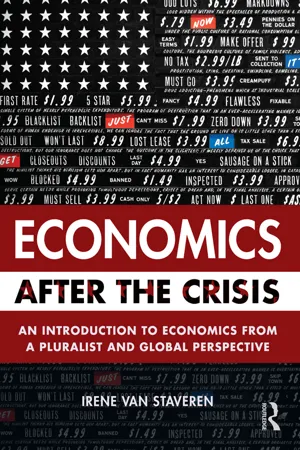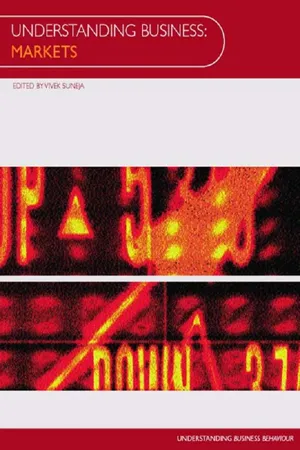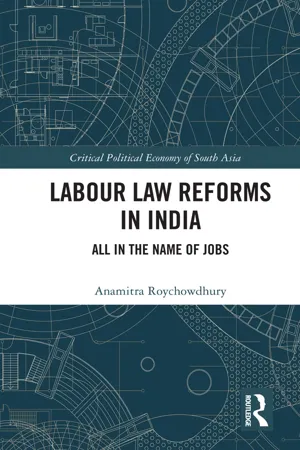Economics
Elasticity of Demand for Labour
Elasticity of demand for labor measures the responsiveness of the quantity of labor demanded to changes in wages. If the demand for labor is elastic, a small change in wages will lead to a relatively larger change in the quantity of labor demanded. In contrast, if the demand for labor is inelastic, changes in wages will have a smaller impact on the quantity of labor demanded.
Written by Perlego with AI-assistance
Related key terms
10 Key excerpts on "Elasticity of Demand for Labour"
- eBook - ePub
- Neil Harris(Author)
- 2007(Publication Date)
- Routledge(Publisher)
L is the market supply curve of labour and has, largely, the same shape as the supply curves we met in the markets for goods and services, i.e. output. This says that the supply of labour will be determined by the wage rate offered – the higher the wage rate the more people will be willing to work. However, the reader will note that it bends back to the left. As wages get very high people can have a good living standard and work fewer hours; in other words they substitute leisure for income, working fewer hours.Where the two curves intersect determines the equilibrium wage rate in the labour market – W0 in Figure 6.8 , with quantity Q0 employed. If there are any changes in the factors determining the demand for and/or supply of labour then the curves will shift to left or right in the same way that curves shift in the output markets.The Elasticity of Demand for Labour will be determined by a number of factors including: 1 The elasticity of the demand for the output produced by labour; the more elastic the demand for the product the more elastic the demand for labour will be.2 The extent to which other factors, particularly capital, including communication and information technology, can be substituted for labour, i.e. the more elastic their supply curves (the easier it is to substitute them for labour), the more elastic the demand for labour will be.3 The more wages account for total costs of production, the more elastic will be the demand for labour, since businesses will want to substitute other cheaper factors. 4 The longer the time period under consideration; since a longer period allows more time for new substitutes for labour to be developed. The elasticity of supply of labour will be determined by:1 The ease of changing jobs; the easier and cheaper it is to do so, the more elastic the supply curve will be. As one gets older it can become more difficult to change jobs because of family and social ties keeping one in a particular location, known as geographical immobility of labour, or because training is required which takes time and loss of income from the job one has given up, known as occupational immobility of labour. - eBook - ePub
- Arthur Cecil Pigou(Author)
- 2013(Publication Date)
- Routledge(Publisher)
a fortiori for the elasticities relevant to longer periods.1 The following table gives the percentage deficiency in wage-rates associated with a 10 per cent excess of demand for various elasticities of demand in respect of the initial (lower) quantity of labour demanded, upon the assumptions that over the relevant range the demand function is (1) linear, (2) a constant elasticity function.Passage contains an image CHAPTER III THE DETERMINATION OF THE SHORT-PERIOD Elasticity of Demand for Labour IN PARTICULAR OCCUPATIONS, IN RESPECT OF A GIVEN REAL WAGE-RATE, IN CONDITIONS OF FREE COMPETITION
§ 1.PROVIDED that employers in any centre are not in a position to exercise monopolistic power against their customers, the quantity of labour demanded there at any given rate of real wage is such that the value in terms of wage-goods of its marginal net product (i.e. of the difference made to the total physical yield by the marginal man with the help of existing equipment)1 approximates to that rate of wage plus the rate of employers’ contribution to sickness and unemployment insurance. Henceforth, for economy of language, I shall use the term wage to include these elements, so that reference to them need not again be made. If, then, conditions of competition being assumed, we write x for the quantity of labour employed in any occupation and F′(x) for the rate of wage, as above defined, in terms of wage-goods, the elasticity of the real demand for labour in respect of a quantity x may be written . The purpose of this chapter is not to provide any concrete information, but to set out in an orderly way the questions that must be answered if we are to determine the value of Ed - eBook - ePub
Modern Labor Economics
Theory and Public Policy
- Ronald Ehrenberg, Robert Smith, Kevin Hallock(Authors)
- 2021(Publication Date)
- Routledge(Publisher)
Suppose, for example, that the elasticity of product demand among a firm’s customers were zero; in this case, a rising wage rate would create only a substitution effect. With a larger labor share and thus a higher ratio of labor to capital, the percentage fall in labor usage as wages rise will tend to be smaller, thus causing the elasticity of demand for labor to be smaller. For more on the effects of labor’s share on the elasticity of demand, see Saul D. Hoffman, “Revisiting Marshall’s Third Law: Why Does Labor’s Share Interact with the Elasticity of Substitution to Decrease the Elasticity of Labor Demand?” Journal of Economic Education 40 (Fall 2009): 437–445. Hoffman also argues that the third law holds only when the elasticity of final product demand is greater than the elasticity of substitution. 6. Daniel S. Hamermesh, Labor Demand (Princeton, NJ: Princeton University Press, 1993): 103. 7. An analysis of the wages and employment of U.S. women in the period following World War II estimates that the overall elasticity of demand for their labor was similar—in the range of –1.0 to –1.5. See Daron Acemoglu, David H. Autor, and David Lyle, “Women, War and Wages: The Effect of Female Labor Supply on the Wage Structure at Midcentury,” Journal of Political Economy 112 (June 2004): 497–551. Estimates of the own-wage elasticity of demand for higher-skilled and lower-skilled manufacturing labor in Germany are somewhat lower (–0.6 to –1.3); see John T. Addison, Lutz Bellmann, Thorsten Schank, and Paulino Teixeira, “The Demand for Labor: An Analysis Using Matched Employer–Employee Data from the German LIAB. Will the High Unskilled Worker Own-Wage Elasticity Please Stand Up?” Journal of Labor Research 29 (June 2008): 114–137. A recent study of labor demand elasticities across U.S - eBook - ePub
- Andrew Barkley, Paul W. Barkley(Authors)
- 2016(Publication Date)
- Routledge(Publisher)
Elasticities are unitless, and therefore attractive to social scientists who make comparisons among elasticities across all goods. The definition of price elasticity makes this clear:(9.7) Ed = (ΔQd /ΔP)*(P/Qd ).Since the price (P) and quantity demanded (Qd ) appear in the numerator and the denominator, the units of each cancel, leaving no units for an elasticity calculation. Hence, economists use elasticities rather than slopes to measure the responsiveness of consumer purchases to changes in prices and other economic variables. These unitless elasticities allow an unbiased comparison of the market responsiveness of apples and oranges.To summarize the discussion, elasticities measure how responsive consumers are to changes in price. An elastic demand curve shows that consumers are more responsive to price changes, while an inelastic demand curve reveals that consumers are not so likely to change their buying habits in response to price changes. The elasticities are comparable across all goods. The major determinant of the elasticity of demand is the availability of substitutes. If substitutes are available, then, when the price of a good increases, consumers switch to the lower-priced product.The price elasticity of demand explains many market-related situations. For example, gasoline stations in college towns often charge higher prices for gasoline the day before the beginning of Spring Break. On this day, when several thousand students are preparing to leave town, the demand for gasoline is relatively inelastic: many of the students will fill their cars’ tanks. Station owners know this and increase the price of fuel to take advantage of the fact that the students will pay higher prices in order to fulfill their vacation plans.Veterinarians often charge higher prices for rich people with poodles than for poor people with mixed breed mutts. Why? Because wealthier people are more likely to be willing and able to pay higher prices for vet services than poor people are. The elasticity of demand for medical services is lower (more inelastic) for rich persons than for poor. - eBook - ePub
- Dr Paul Balchin, Paul Balchin, Maureen Rhoden(Authors)
- 2002(Publication Date)
- Routledge(Publisher)
1 ) would cause a rise in equilibrium rents. Some former tenants would now see owner-occupation as a better alternative and some (relatively small) shift to the right of demand for owner-occupied housing would occur, putting some downward pressure on equilibrium price. However, since these former privately rented houses would not actually disappear but would most likely be sold for owner-occupation, there would also be a shift right of the supply of owner-occupied housing, putting downward pressure on equilibrium price in this sector.Figure 2.7 Shifts in demand and supplyFigure 2.8 The long-run supply curve for an industryPRICE, INCOME AND SUPPLY ELASTICITIES
From our previous analysis, we know that price influences both the quantity consumers demand and the quantity producers are willing to supply. The quantitative effect on demand or supply may range from quite small to very large. The economic term to describe such responsiveness is elasticity. A high degree of elasticity implies a high level of responsiveness and vice versa.Price elasticity of demand
This represents a measure of the responsiveness of demand to changes in the price of a commodity, as we move along a demand curve. It is defined as follows, where Ed stands for elasticity of demand.For example, if a 10 per cent rise in price results in a 20 per cent fall in quantity demanded, the value of elasticity can be calculated as:Figure 2.9 Demand and supply in the housing marketThe possible values of Ed vary from zero to (-) infinity. Examples of elastic and inelastic demand curves are given in Figure 2.10 . Figure 2.10a shows an inelastic demand curve. A fall in price from P0to P1causes a proportionately smaller rise in quantity demanded (q0to q1). A rise in price (P1to P0) would have produced a proportionately smaller fall in quantity demanded (q1to q0 - eBook - ePub
- John Smithin(Author)
- 2008(Publication Date)
- Routledge(Publisher)
Figure 7.5 , itFigure 7.5 Under imperfect competition aggregate demand changes can affect the demand for labor.is true that measured unemployment does fall. However, this is only if unemployment is defined in a “commonsense” (or technical) manner as the change from (N max –N 1) to (N max –N 2). As already pointed out, this might be challenged on the grounds that this is not the “correct” definition, at least in terms of the microeconomic theory of choice. The rebuttal to this argument, however, has also already been given. namely, that this distinction may not matter very much for the practical explanation of observed employment and unemployment outcomes. Even the very meaning or relevance of the terms voluntary and involuntary, as applied to macroeconomic data, is clearly very much open to question.A further point that is not often noticed about a diagram like Figure 7.5 is that, even looking at matter from the standpoint of the orthodox consumer choice theory, the level of employment N 2 in Figure 7.5 (with a higher real wage and lower measured unemployment than at N 1) certainly yields a higher level of so-called utility than the situation at N 1. This is so even if both equilibria are themselves “chosen” positions (under different circumstances). This conclusion simply follows from the construction of the supply curve out of the usual apparatus of indifference curves, budget constraints, etc., as shown in every microeconomics textbook. There is, therefore, even on the strictest of neoclassical criteria, and in the specific context of imperfect competition, a clear basis for the advocacy of policy options to increase employment and reduce unemployment. The reason for this, of course, is that the presumption of imperfect competition itself automatically reduces “welfare”, and hence in principle must allow for policy options to reverse that situation. Admittedly, it is probably not very useful, even in this case, actually to resort to this type of jargon in discussing the policy choices that have to be made in the real world, but the point of these remarks is simply to show that it is possible - eBook - ePub
Economics After the Crisis
An Introduction to Economics from a Pluralist and Global Perspective
- Irene van Staveren(Author)
- 2014(Publication Date)
- Routledge(Publisher)
c . This happens at the backward bending part of the labour supply curve, where households earn more than enough livelihood and begin to value leisure time more than additional income. Hence, with higher wages, labour supply goes down: less hours per person and/or less household members supplying paid labour. Also, the high income earned allows for a reduction in unpaid work time, by buying more expensive household durable goods (microwaves, dishwashers, cars) and hiring more domestic services or buying ready-made food.Now, suppose that the economy is booming, with relatively high aggregate demand and hence, high demand for labour. This leads to a shift in the labour demand curve to the right (from Ld1 to Ld2 ) and the new labour market equilibrium is at the level of L** of employment. This is the level of full employment, hence, there is no unemployment anymore. We see this in Diagram 8.8 .The new labour demand curve shows two intersections with the supply curve: D and E. Both equilibriums have a higher employment level than before, a shift to the right from L* to L**. In equilibrium D, with wage rate Wd , there is more employment than before at a higher wage rate than with both Wa and Wb . This is because labour is becoming relatively scarce and the opportunity costs of leisure time increase.In equilibrium E, with wage rate We , we also see an expansion of employment to L** as compared to the old equilibrium in the top wage sector, C. But we see a small decline in the equilibrium wage rate from Wc to We .The reason for this small difference is that at such high wage levels, people generally prefer to do more unpaid work and spend more leisure time than do many hours of paid work. But when there is a decline in those high wages, they like to keep their level of high income, so as to afford a luxurious standard of living. As a consequence, they will supply more labour hours per individual and/or per household. - INTERNATIONAL MONETARY FUND(Author)
- 1997(Publication Date)
- INTERNATIONAL MONETARY FUND(Publisher)
16 Increases in the elasticity of employment with respect to real wage changes also point to increasing flexibility in the labor market. In turn, the decline in the discouraged-worker effect and the decrease in lagged employment effects in the labor force equation indicate possible increases in the flexibility of labor supply. Finally, wage bargaining patterns may have changed, as the evidence suggests that wage staggering effects have decreased.The United Kingdom also shows that the underlying patterns of behavior in the labor market seem to have changed under the impetus of policy initiatives taken during the 1980s. These were mainly in the sphere of reform of industrial relations, which raised the costs of strikes, eased hiring and firing costs, and promoted the decentralization of wage bargaining (see Henry and Karanassou (Chapter 5 ) for details). These reforms might be expected to affect both employment flexibility and the responsiveness of wages.Unlike in Italy, labor market reforms in the United Kingdom have been in place long enough to enable direct tests of structural change in employment and wage equations to be made. The results of these tests show that the principal effects of the reforms have been on employment. This is consistent with there being some easing of hiring and firing constraints on firms. Ascertaining the scale of this improvement is not straightforward, however. The evidence from the employment demand equation is that the overall effect, although not statistically significant on conventional tests, may nonetheless be quantitatively important. This result may be affected by the level of aggregation used, however, and effects at the manufacturing level, for example—where adjustment costs are probably significantly larger than elsewhere—could be larger.- eBook - ePub
Understanding Business: Markets
A Multidimensional Approach to the Market Economy
- Vivek Suneja, Vivek Suneja(Authors)
- 2005(Publication Date)
- Routledge(Publisher)
extent to which demand changes as income changes. Income elasticity of demand measures the sensitivity of demand to changes in income. If consumers get an increase in income, their demand for some products may rise substantially, but their demand for other products may rise only very slightly, if at all.Income elasticity of demand can be measured by using the formula:If the value is more than one, demand is said to be income elastic, and if the answer is between zero and one, demand is said to be income inelastic. Most goods will fall into this range: that is, their income elasticity of demand will be positive, and the higher the value of the income elasticity of demand, the stronger the relationship is between changes in income and changes in demand. Luxury products tend to have a high income elasticity, while necessities have a low income elasticity. Thus the demand for foreign holidays or eating out is likely to be fairly responsive to changes in income, but the demand for bread is unlikely to change by much as income changes.For some products, however, the income elasticity of demand is negative, and these are referred to as inferior products. For these products there is an inverse relationship between income and demand, and an increase in income will lead to a fall in demand. The explanation for this is that as their income rises, consumers substitute better products in place of the ‘inferior’ products. Typical examples are public transport or cheap cuts of meat.Knowledge of the income elasticity of demand is important as it can help us to predict what will happen to demand as income levels change. Over time, living standards and the level of income have a tendency to rise. Using data on the income elasticity of demand for products, we can predict changes in spending patterns. We can expect to see a rise in spending on those products which have a high income elasticity of demand, such as eating out, electrical goods, foreign holidays and leisure activities, whereas for those products which have a low income elasticity of demand – for example, necessities such as bread, toothpaste, washing-up liquid – demand will rise only slightly. Expenditure on those products which have a negative income elasticity will fall. Thus the demand for public transport may fall as people switch to private cars. - eBook - ePub
Labour Law Reforms in India
All in the Name of Jobs
- Anamitra Roychowdhury(Author)
- 2018(Publication Date)
- Routledge India(Publisher)
According to the Classical school, the marginal product curve of labour is the labour demand curve, and like typical demand curves, the quantity of labour demand (or employment at the short side of the market) is determined by the independent variable i.e., price of labour (real wage rate). Therefore, in the Classical framework, labour demand is determined by the equation N D = f (real wage). 22 Thus, corresponding to real wage W 1, employment is determined on the labour demand schedule at N 1, and excess labour supply or unemployment is N 2 – N 1. Figure 6.1 Aggregate labour market Now the Classical school explains persistence of unemployment by downward rigidity of real wages. In other words, employment remains arrested at N 1 because trade unions run a ‘closed shop’. Hence, a necessary and sufficient condition for the labour market to clear – according to the Classical theory – is to remove such labour market imperfections (by delegitimising trade union activity or complete removal of hiring and firing costs), which allows the real wage to adjust to W*. Of course, it is granted that workers – in absence of labour market imperfections – would engage in undercutting money -wages and bring down the real wage to the market clearing level, curing unemployment. Let us see what this involves. For simplicity, let us assume that the economy is characterized by a Classical savings function (i.e. all wages are consumed and all profits are saved). Now, for historical reasons, if real wage is W 1, then employment is grounded at N 1. The magnitude of total output is given by the area under the marginal product curve to the left of N 1 by the area, acde. The wage bill is obtained by multiplying the wage rate with the level of employment and is denoted in the figure by bcde. Since national income is distributed between only two categories of income 23 – wages and profits – profits are represented by abc. Now, the nature of capitalist production is commodity production (i.e
Learn about this page
Index pages curate the most relevant extracts from our library of academic textbooks. They’ve been created using an in-house natural language model (NLM), each adding context and meaning to key research topics.









